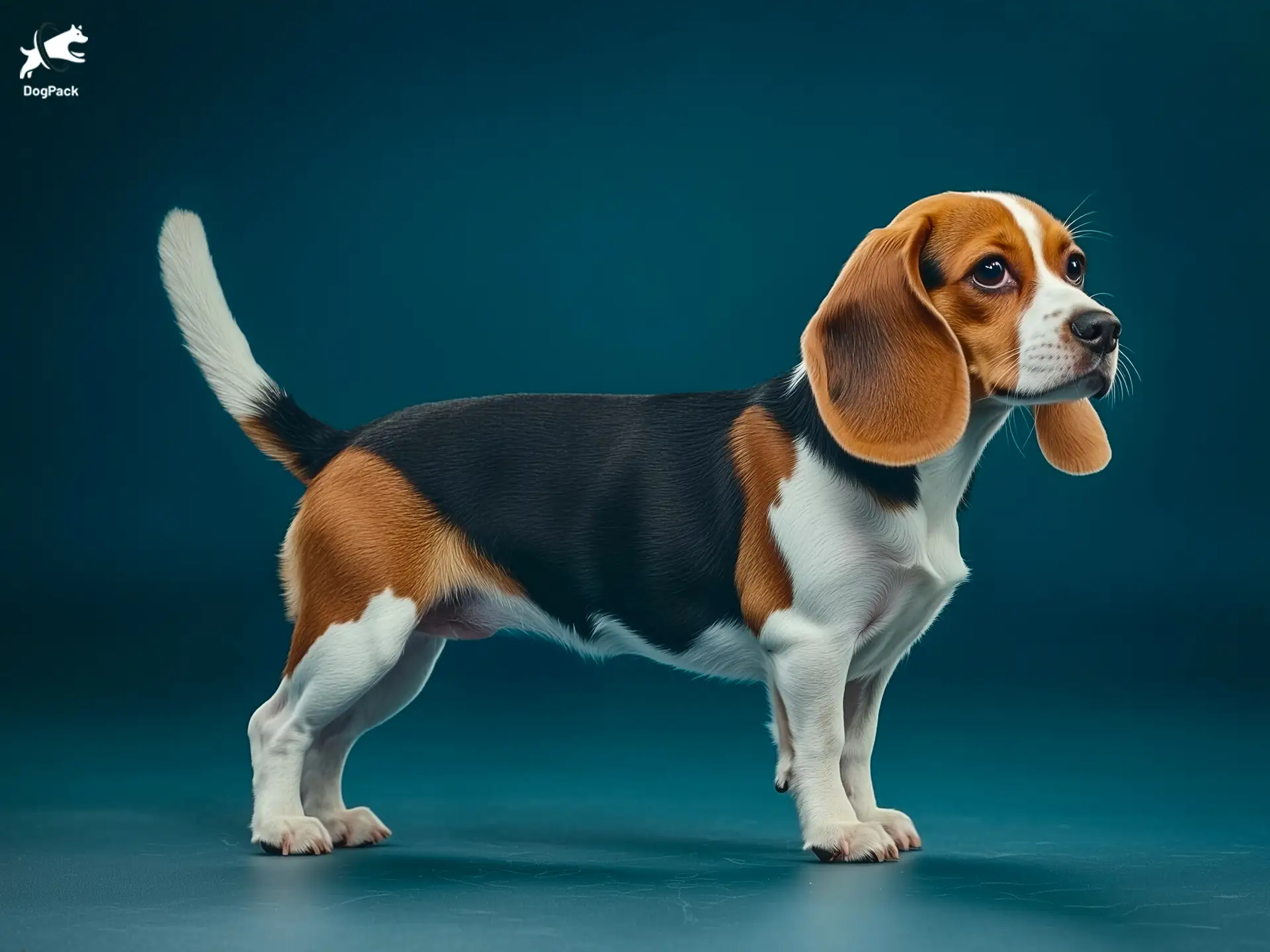Pocket Beagle Dog Breed Info & Overview
This pint-sized charmer is full of big personality, capturing hearts with its friendly nature and adorable looks. Despite being a fraction of a standard Beagle’s size, the Pocket Beagle offers the same classic hound traits. Cheerful, curious, and packed with energy, these tiny pups are truly something special for families seeking a fun companion.
Characteristics
Pictures
Breed History
In the 16th century, English nobles adored smaller hounds that could fit in a saddlebag, which soon became known as “pocket” or “glove” beagles. Legend has it Queen Elizabeth I was especially fond of these petite canines, letting them roam the palace grounds and entertain her guests. Though their exact lineage is debated, they’re a miniature offshoot of traditional Beagles, prized for their compact size and keen senses.
Over the centuries, these tiny hounds gained popularity for their ability to sniff out game in thick underbrush where larger dogs couldn’t fit. Hunters found the small stature of these miniature canines useful, as they could slip through tight spots and remain agile on challenging terrains. Their unwavering nose and determined spirit helped them track rabbits, hares, and other small animals with exceptional skill.
While never officially recognized as a distinct breed by major kennel clubs, the ‘Pocket Beagle’ label remains a cherished nickname for these undersized companions. They’re often sought after for their adorable proportions and storied past. Today, enthusiasts appreciate the historical charm and novelty these diminutive dogs bring, honoring a lineage that’s entwined with centuries of English hunting tradition and royal admiration.
Temperament, Personality
These cheerful pups are famous for their bright-eyed curiosity and eagerness to greet both friends and strangers with a wagging tail. In typical beagle fashion, they love to sniff everything in sight and are always ready for a new adventure. Loyal yet independent, they thrive on companionship but still appreciate moments to explore the world with their inquisitive nose.
Despite their small stature, these lively canines can stand up for themselves when needed. They rarely show aggression, but their strong hunting instincts can surface if they catch a tempting scent. Providing enough mental and physical stimulation is crucial to keep them out of mischief, as boredom can lead to creative attempts at finding excitement—usually by following their nose.
The Pocket Beagle is especially good-natured, making it a hit with kids and other dogs, though early socialization is still recommended. Patience is key when training, as these pups can be a tad stubborn. With consistent guidance and plenty of positive reinforcement, they’ll develop a sweet, well-rounded disposition that will brighten any household.
Physical Characteristics
At first glance, these miniature hounds resemble their standard counterparts, sporting long, droopy ears, soulful eyes, and a sturdy build. Their compact size, however, sets them apart, typically weighing under 15 pounds and standing less than a foot tall at the shoulder. With their short coat and classic tricolor or bicolor markings, they maintain the unmistakable beagle look in a smaller package.
Although small, they’re surprisingly muscular, built to traverse fields and chase down little critters. Their head is slightly domed, with a medium-length muzzle that houses a powerful sense of smell. Those big, round eyes hold a curious sparkle, reflecting their high-spirited outlook on life. Overall, their balanced proportions support stamina and agility, making them capable hunting companions for short hunts.
The Pocket Beagle’s coat is typically short, dense, and weather-resistant, needing minimal grooming to stay presentable. Their tail, often carried high, offers a playful wag that signals their upbeat mood. Thanks to their sturdy frame, these dogs can handle rough play, though they’re still delicate enough to appreciate gentle handling. It’s a harmonious blend of robust features and miniature proportions.
Health Issues
Like their bigger cousins, these smaller hounds can be prone to hip dysplasia and patellar luxation, where the kneecap shifts out of place. Ear infections are also common due to their floppy ears, which trap moisture and create a breeding ground for bacteria. Regular checkups and proper ear cleaning can prevent many of these issues from escalating into major problems.
Obesity poses a significant threat if left unchecked, particularly because these dogs love to eat just as much as they love to sniff. Carrying excess weight amplifies stress on joints and can exacerbate existing conditions. Maintaining a balanced diet and consistent exercise routine helps ward off weight gain and keeps their bodies in optimal shape for a long, healthy life.
For the Pocket Beagle, regular veterinary exams are invaluable for catching genetic disorders early. Intervertebral disc disease, though less common, can still appear in some lines. Keeping an eye on spinal health and avoiding excessive jumping can go a long way in prevention. Ultimately, responsible breeding and attentive care form the foundation of a happy, vigorous companion.
Grooming Needs
These compact canines are relatively low-maintenance, thanks to their short and sleek coat that’s easy to brush. A weekly once-over with a soft-bristle brush or grooming mitt usually keeps shedding under control and promotes healthy skin. They do experience seasonal shedding, so expect to find some extra fur around the house during certain times of the year.
Ear care is a must, given their floppy ears and love for outdoor adventures. Gently wiping the ear canal with a vet-approved solution prevents buildup of wax and debris, reducing the risk of infection. Bathing is best done occasionally, or when they become noticeably dirty. Over-bathing can strip the coat’s natural oils, so moderation is key to maintaining coat health.
The Pocket Beagle typically needs nail trims every few weeks, as overly long nails can cause discomfort or affect their gait. Teeth cleaning is also essential, especially given their passion for treats. Regular brushing or using vet-recommended dental chews can reduce tartar buildup and improve overall oral health. Keeping a consistent routine ensures a fresh, clean companion by your side.
Exercise Requirements
Although small, these hounds still carry the classic beagle drive that craves excitement and exploration. A daily walk or two, paired with some backyard playtime or a fun sniffing game, often suffices. Mental enrichment, like puzzle toys filled with tasty morsels, helps prevent boredom and channels their natural hunting instincts in a controlled manner.
Short bursts of intense play, such as fetch or hide-and-seek, can work wonders for burning off energy. Be prepared for potential wanderlust if they catch a whiff of something intriguing, so secure, fenced-in areas are a must. With consistent exercise, they remain fit, reduce the risk of weight gain, and keep their mischievous tendencies at bay.
Most Pocket Beagle owners also recommend occasional trips to dog parks for socialization. However, ensure your pup is well-socialized to avoid overwhelmed moments with bigger, more boisterous dogs. Balancing structured walks, interactive games, and monitored off-leash play will help these tiny hounds stay content, channeling their curiosity into healthy, constructive outlets rather than unplanned escapades.
Training Tips
Brimming with a keen sense of smell, these petite explorers can become distracted by scents wafting through the air. Patience and consistency are essential when training, as they might momentarily tune out commands if an interesting smell is in the vicinity. Short, focused sessions work best, using tasty treats or affectionate praise to keep them motivated and attentive.
Employ positive reinforcement techniques rather than harsh corrections. These dogs respond exceptionally well to encouragement and quickly shut down if they sense frustration. Establishing a routine with set training times helps build consistent habits, and introducing basic obedience early ensures good manners in various environments. Leash training is vital to prevent unexpected detours when a compelling scent crosses their path.
For the Pocket Beagle, mental challenges like scent-based treasure hunts can enhance their learning potential. Incorporate games where they must find hidden treats or follow a short trail, encouraging them to use their nose productively. Over time, you’ll see a confident, well-mannered companion, equipped with the self-control to resist every tempting smell that drifts their way.
Nutrition, Diet
A typical adult Pocket Beagle weighing around 10 pounds may require approximately 300 to 400 calories per day, divided into two meals. Choosing a high-quality kibble formulated for small breeds ensures nutrient density without excessive fillers. Look for ingredients like real meat, whole grains, and vegetables that support healthy digestion and sustained energy levels.
For pups, opt for puppy-specific formulas that cater to their rapid growth needs, offering higher protein and fat content. Monitor their weight closely, adjusting portions as needed to avoid unhealthy gains. Because these miniature hounds love to scavenge, keep treats to about 10% of their daily caloric intake. This helps maintain an ideal body condition as they mature.
Protein sources such as chicken or fish offer lean benefits, while moderate amounts of healthy fats boost their coat sheen. Steer clear of excessive carbohydrates that can lead to energy spikes, especially with an active breed. If you notice fluctuations in body shape or reduced activity, consult a veterinarian for personalized dietary adjustments to keep your dog in top condition.
Adoption, Breeders
If you’re considering adding a Black Mouth Cur to your family, adoption is a great option. Organizations like the Black Mouth Cur Rescue specialize in rehoming this breed. Shelters in the Southern U.S. often have these dogs available.
If you prefer a puppy from a breeder, make sure to choose a reputable one. Look for breeders who conduct health screenings and are transparent about the dog’s lineage. The National Kennel Club recognizes the breed and can be a resource for finding registered breeders.
Avoid puppy mills or any source that seems unethical. A responsible breeder will prioritize the health and temperament of their dogs.
Family Pet?
Families often appreciate these mini hounds for their upbeat attitude and gentle disposition. They’re generally patient with children, though it’s wise to teach kids respectful handling and avoid overly rough play. Because of their playful spirit, they can spend hours chasing a ball in the yard or curling up with the family on the couch.
Socializing them with other pets early on usually pays off, as they tend to be friendly if introduced correctly. However, their hound instincts might prompt them to chase smaller critters, so careful supervision is important, especially with cats or rodents. This breed loves being part of daily routines and may follow you around, seeking attention whenever possible.
For a Pocket Beagle in a bustling household, consistency in training and daily interaction fosters good manners. Loud noises or hectic environments generally don’t rattle them, although they do enjoy the option to retreat to a quiet corner if they need downtime. Ultimately, these sociable pups thrive in affectionate, active families that can match their curious, energetic nature.
Right For You?
Before bringing one home, consider whether you have the time for daily walks and mental stimulation. These inquisitive dogs flourish in environments where they can safely sniff and explore. They aren’t couch potatoes, yet they don’t demand nonstop activity. If you can commit to a moderate exercise routine and ongoing training, you’ll likely find them a wonderful match.
Small living spaces can work if you manage noise levels, as their signature bay can be loud when they catch a scent or get excited. Neighborhoods with strict noise ordinances might pose a challenge unless you commit to training them to bark less. A yard for supervised play is ideal, but apartment-dwellers who schedule ample walks can still maintain a content pup.
For potential owners seeking a friendly companion with a smidge of independence, the Pocket Beagle checks many boxes. They bond closely with their families, greeting guests with wagging enthusiasm. As long as you’re up for a bit of hound-like mischief and can provide consistency in training, you’ll enjoy the playful, affectionate spirit these little dogs have to offer.
Conclusion
In the end, the Pocket Beagle combines a lively hound spirit with an irresistibly cute size, making it a popular choice for those seeking a smaller companion without losing that classic beagle charm. Their friendly temperament, inquisitive nature, and moderate exercise demands can suit families, singles, or seniors alike. Of course, consistent training, proper socialization, and a healthy diet are essential to keep this pup content and thriving. If you can devote the necessary time and attention, you’ll be rewarded with a loyal sidekick who’s always ready to share new adventures and comforting snuggles. The key is understanding their unique traits, embracing their curiosity, and meeting their needs with love and patience.
FAQs
-
What makes the Pocket Beagle different from a standard Beagle?
The Pocket Beagle is significantly smaller than the standard version, typically standing under 13 inches tall. Originally bred for “pocket-sized” royal hunts, it shares the same scenting skills but is better suited for apartment living and lap companionship.
-
Were Pocket Beagles really carried in pockets?
Yes, Pocket Beagles were once small enough to ride in saddlebags or coat pockets during royal hunts in Elizabethan England. While today’s versions are slightly larger, the name reflects their history as miniature scent hounds used for intimate tracking outings.
-
Do Pocket Beagles have the same howl as larger Beagles?
Despite their size, the Pocket Beagle maintains that classic Beagle bay or howl. It may sound a bit higher-pitched, but it’s equally loud and expressive, especially when following a scent or feeling left out of the action.
-
Are Pocket Beagles recognized as a separate breed by kennel clubs?
The Pocket Beagle is not officially recognized as a separate breed by the AKC. It is considered a smaller variation of the Beagle, often produced through selective breeding for size, rather than being a distinct classification.
-
Is the Pocket Beagle suitable for scent detection work?
Yes, the Pocket Beagle retains strong scenting instincts, making it an excellent candidate for nose work or scent detection games. Though smaller, its olfactory ability is just as sharp as larger hounds, especially in tracking or food-based puzzles.
Breed Ratings
Pocket Beagle dogs are clever and curious, though their powerful noses can sidetrack training sessions if not guided consistently.
Bursting with energy and curiosity, they love interactive toys, games, and engaging with family members at every opportunity.
They require daily walks and mental games to burn off steam, but they also enjoy restful cuddle sessions once content.
Their short coat is easy to maintain, though seasonal shedding does occur, especially during warmer months or climate changes.
As a scenthound, they’ll readily chase small animals or dart after intriguing smells, requiring vigilance during outdoor excursions.
Short coats and minimal tangles make grooming simple, though regular ear checks and nail trims remain essential chores.
Willing to learn yet easily distracted by scents, they respond best to positive methods and patient, consistent leadership.
They’re social and may become anxious when left solo too long. Sufficient companionship and mental activities curb unwanted behaviors.
Known for that classic hound bay, they can be vocal if bored or excited, so proactive training helps in managing noise.
They aren’t heavy droolers, though occasional slobber might appear, especially after active play sessions or drinking water.
Generally amiable with canines of similar energy, early socialization fosters positive encounters and reduces territorial instincts.
Prone to certain joint issues and obesity if overfed, they benefit from regular vet care, proper diet, and consistent exercise.













